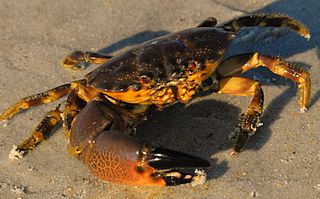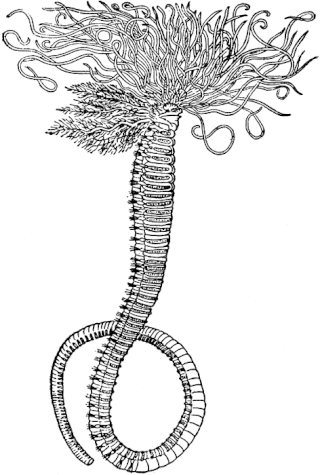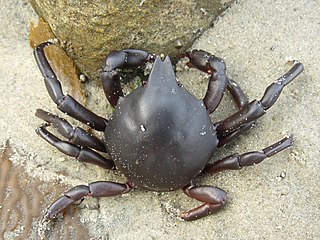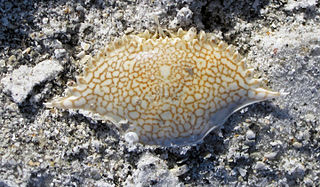
Porcelain crabs are decapod crustaceans in the widespread family Porcellanidae, which superficially resemble true crabs. They have flattened bodies as an adaptation for living in rock crevices. They are delicate, readily losing limbs when attacked, and use their large claws for maintaining territories. They first appeared in the Tithonian age of the Late Jurassic epoch, 145–152 million years ago.

The Florida stone crab is a crab found in the western North Atlantic, from Connecticut to Colombia, including Texas, the Gulf of Mexico, Belize, Mexico, Jamaica, Cuba, The Bahamas, and the East Coast of the United States. The crab can also be found in and around the salt marshes of South Carolina and Georgia. It is widely caught for food. The closely related species Menippe adina is sometimes considered a subspecies – they can interbreed, forming hybrids – and they are treated as one species for commercial fishing, with their ranges partly overlapping. The two species are believed to have diverged approximately 3 million years ago.

Carcinus maenas is a common littoral crab. It is known by different names around the world. In the British Isles, it is generally referred to as the shore crab, or green shore crab. In North America and South Africa, it bears the name European green crab.

Grapsus grapsus is one of the most common crabs along the western coast of the Americas. It is known as the red rock crab, or, along with other crabs such as Percnon gibbesi, as the Sally Lightfoot crab.

Chaetopterus or the parchment worm or parchment tube worm is a genus of marine polychaete worm that lives in a tube it constructs in sediments or attaches to a rocky or coral reef substrate. The common name arises from the parchment-like appearance of the tubes that house these worms. Parchment tube worms are filter feeders and spend their adult lives in their tubes, unless the tube is damaged or destroyed. They are planktonic in their juvenile forms, as is typical for polychaete annelids. Species include the recently discovered deep water Chaetopterus pugaporcinus and the well-studied Chaetopterus variopedatus.

Percnon gibbesi is a species of crab. It is one of at least two species commonly called Sally Lightfoot, and is also referred to as the nimble spray crab or urchin crab. It has been described as "the most invasive decapod species to enter the Mediterranean".
Sally Lightfoot may refer to:

Percnon is a genus of crabs in the family Percnidae. It has also been included in the family Plagusiidae as subfamily Percninae.

Chaetopterus variopedatus is a species of parchment worm, a marine polychaete in the family Chaetopteridae. It is found worldwide. However, recent discoveries from molecular phylogeny analysis show that Chaetopterus variopedatus sensu Hartman (1959) is not a single species.
Pinnixa chaetopterana, the tube pea crab, is a small decapod crustacean that lives harmlessly within the tube of the polychaete worm, Chaetopterus variopedatus.

Amphitrite ornata or ornate worm, is a species of marine polychaete worm in the family Terebellidae.

Loxorhynchus crispatus, known generally as the masking crab or moss crab, is a species of true crab in the family Epialtidae. It is found in the East Pacific.

Taliepus nuttallii, known generally as the southern kelp crab or globose kelp crab, is a species of true crab in the family Epialtidae. It is found in the East Pacific.
Randallia ornata, known generally as the globose sand crab or purple globe crab, is a species of true crab in the family Leucosiidae. It is found in the East Pacific.
Randallia is a genus of true crabs in the family Leucosiidae. There are about 17 described species in Randallia.

Armases is a genus of true crabs in the family Sesarmidae. There are about 13 described species in Armases.

Polyonyx is a genus of porcelain crabs in the family Porcellanidae. There are at least 42 described species in Polyonyx.

Arenaeus is a genus of swimming crabs in the family Portunidae. There are at least two described species in Arenaeus.

Emerita talpoida, known generally as the Atlantic mole crab or Atlantic sand crab, is a species of mole crab in the family Hippidae. It is found in the western Atlantic Ocean and Mexico along the shoreline.














